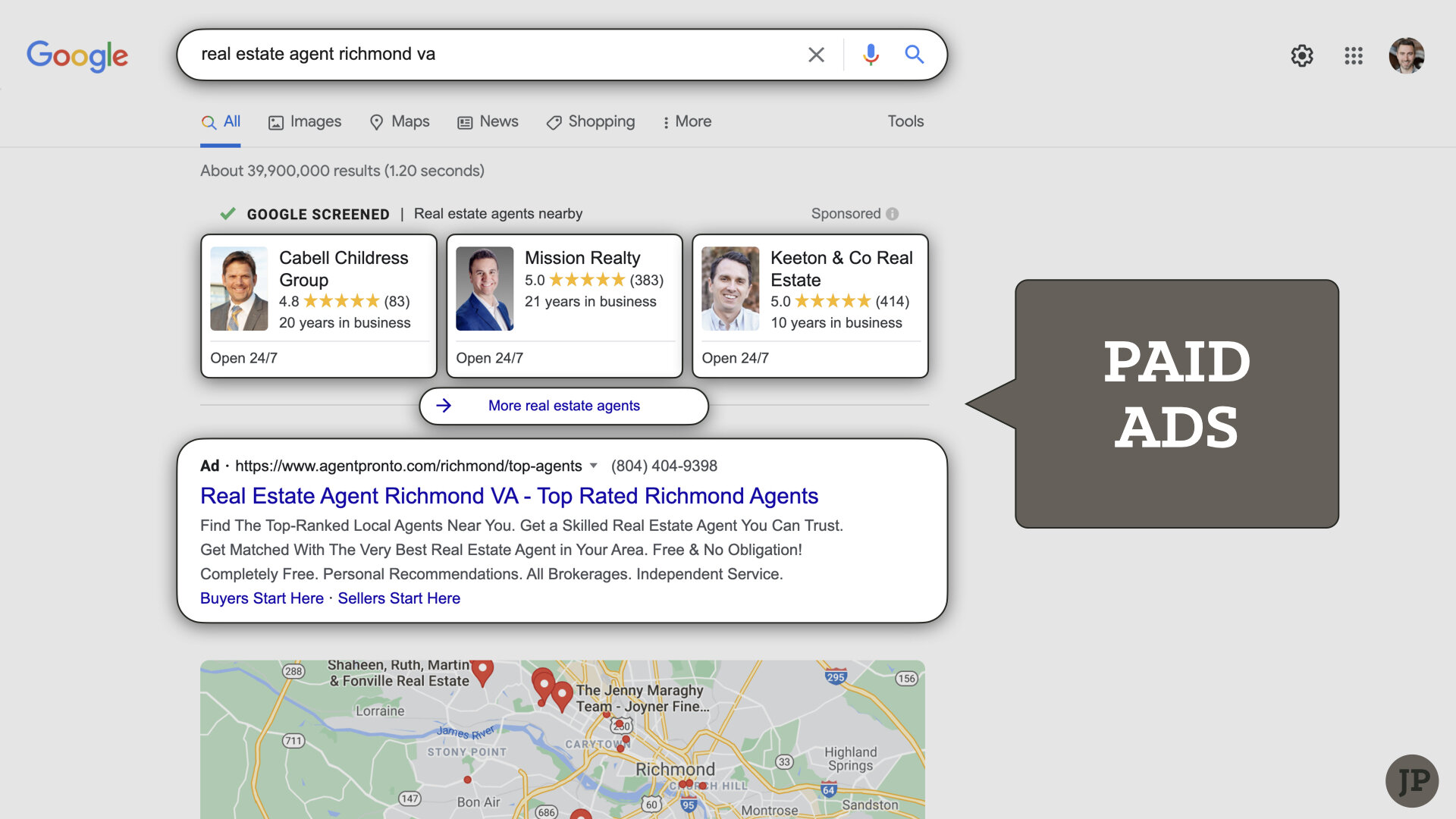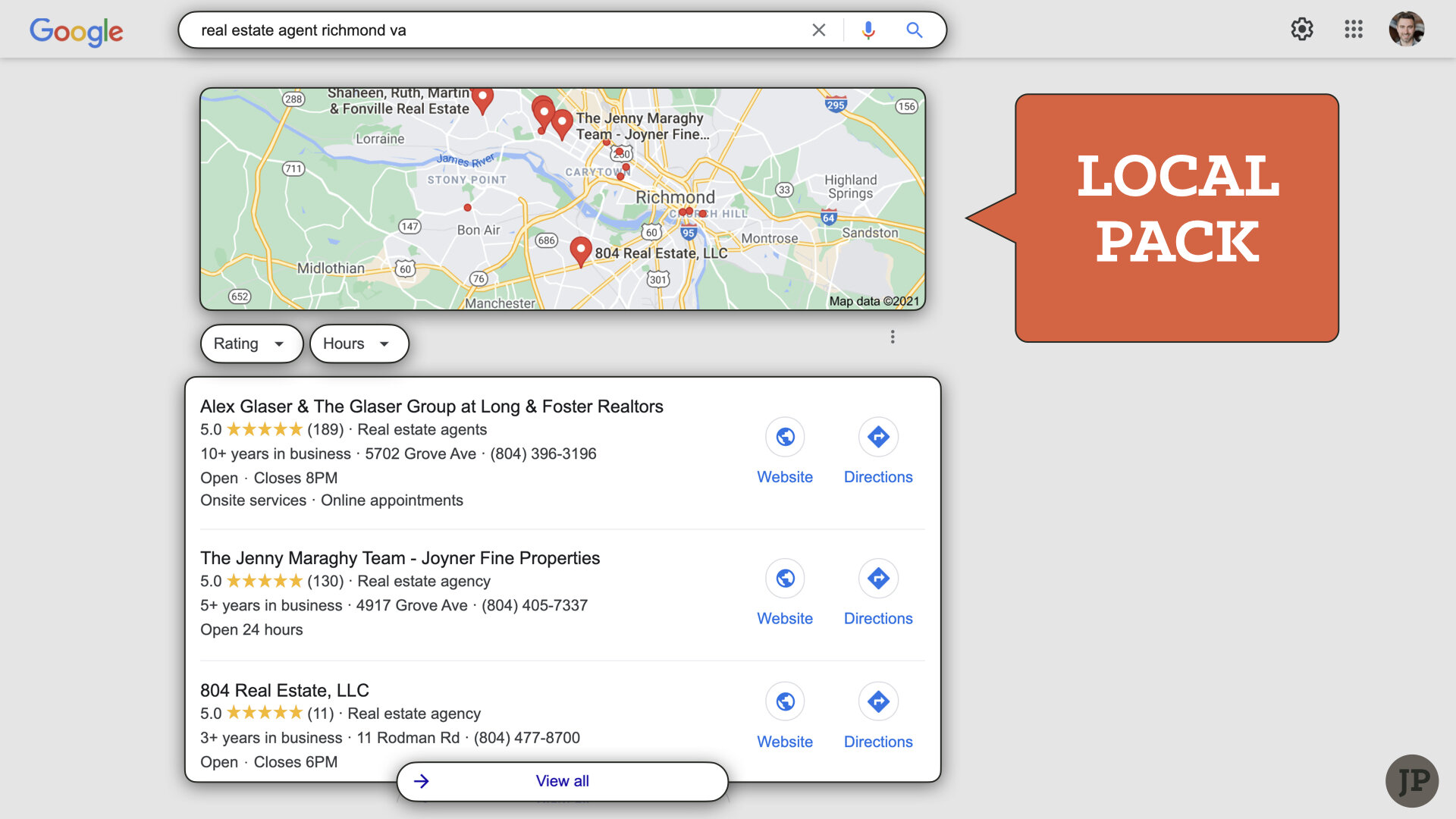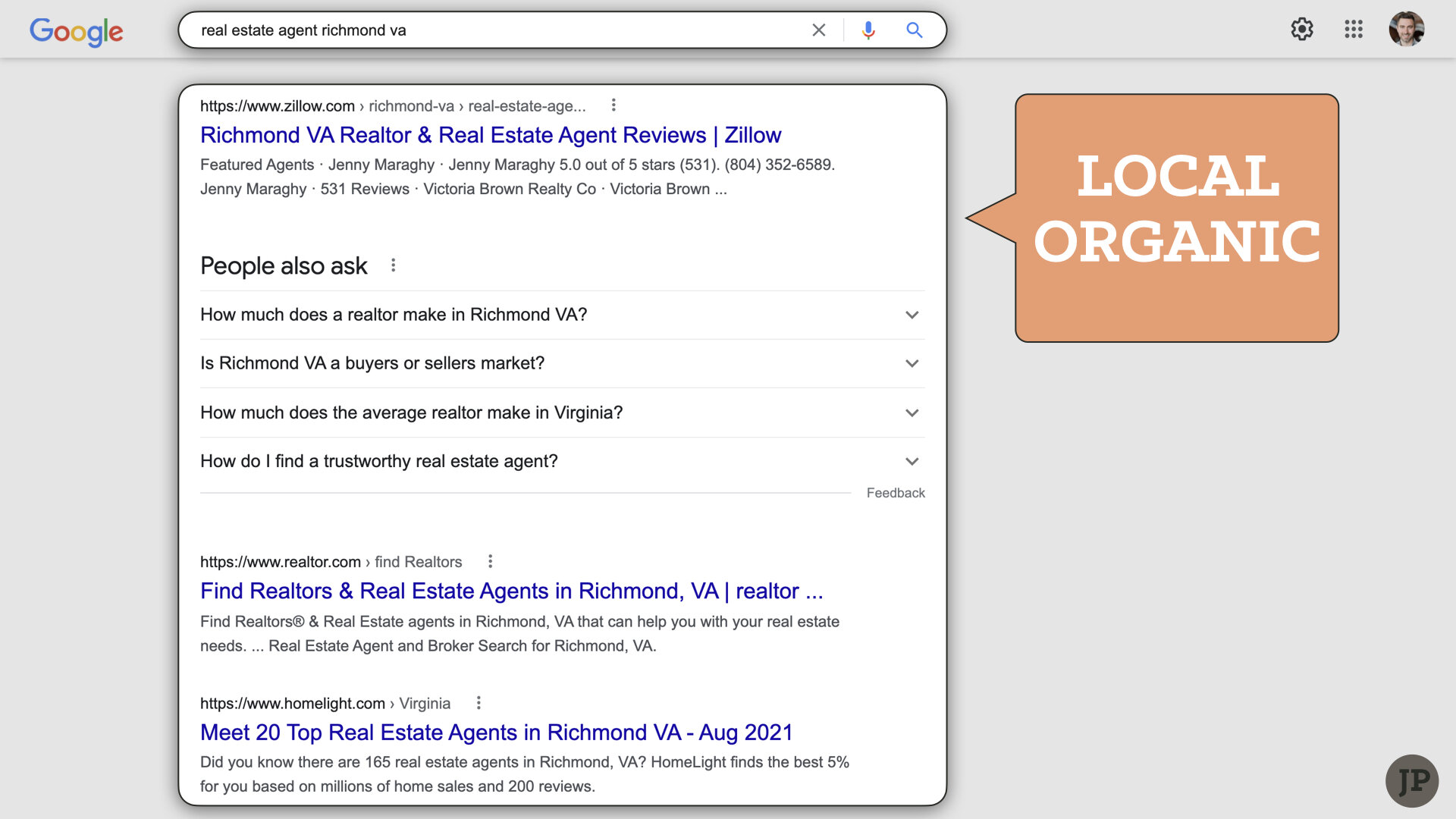For any type of local business—shops, services, and so forth—ranking on local-intent Google searches is extremely advantageous: website clicks, inbound customer calls, messages, and more!
For example, a prospective home seller may enter a search phrase like, “real estate agent nearby.” If you’re a real estate agent who happens to be close-at-hand, that’s the type of search to wanna rank on!
But it’s easier said than done. SEO has never been as simple as ABC.
Whenever Google’s algorithm infers the aim of a search is seeking something or someone local it lists geographically-tuned results (more on this later). Unfortunately, given the algorithm’s inherent complexities—plus extensive competition at the local level—it can be confusing to know exactly where to focus your optimization efforts to maximize the results.
But consider this: per a recent WhiteSpark study, the importance of Google My Business (GMB) has increased greatly over the past several algorithmic updates in terms of its weight in the search results. The point in bringing his up is to suggest that rather than trying to do all-things SEO to rank, it’s strategically viable to simply focus on improving your GMB. (You can breathe a sigh of relief now 😅)
Today’s video-training/blog explores 5 ways to improve the ranking of your GMB—thus, leading to more website traffic, more calls, and, ultimately, more customers!
Components of Google’s (Local) Search Results
If you perform a local-intent search (i.e., not global or generic search), as mentioned, Google generates local results and it divides them into various sections: paid ads, local-pack, and organic results. Images to illustrate each element are attached below.
Local Search’s MVP: Google My Business (GMB)
GMB listings appear inside Google Maps and/or Google Search.
Like I said before, all local-intent searches will trigger a list of geographically tailored results. However, GMB profiles in particular display only when Google infers the searcher is specifically seeking a certain local business—not just generalized local info.
For instance, a search like, “Top kids activities in Nashville on a rainy Saturday,” will populate local results but (probably) not GMB. Point is, GMB is one component of many when it comes to Google’s local search results.
The stronger your GMB profile’s location authority, the more likely it is to display in the search results.
A would-be customer might directly search the name of your business or, and this is the point of today’s video-training/blog, they may search for a business LIKE yours. The question is, will your GMB rank or will it rank your competitor?
Ranking in Google’s “Knowledge Graph”
Once again, GMB profiles may appear in Maps or Search, desktop or mobile. They all function the same algorithmically-speaking (as far as ranking-factors go) but each looks just a tad different from visual standpoint.
In Google Search, for instance, your GMB profile may appear in what’s known as the “Knowledge Graph,” which, when viewed on a desktop browser, displays a section on the righthand portion of the screen that compiles information gathered from multiple sources into one concentrated space. On a mobile device, it’ll appear at the top of the page. Reference the image below.
The Knowledge Graph shows the most info: photos, phone number, a button to visit your website, hours of operation, customer reviews, and more.
Typically a potential customer would have to search the name of your business to trigger the Knowledge Graph. Question is, how strong is the location authority of just “your name?” For example:
Did the searcher type just your name, “Jane Doe,” and that alone had enough location-authority packed in to populate your GMB profile in the Knowledge Graph?
Did the search have to add a geographic modifier, like, “Jane Doe, Nashville,” and that’s what sent it over the edge?
Did they add a job-category modifier, like, “Jane Doe, Realtor” or “Jane Doe, real estate agent,” and that’s what did the trick?
Ultimately, it’s a (not-so-simple) matter of location authority.
Ranking in Google’s “Local Pack”
The other way your profile might rank in Google Search is in what’s known as the “Local Pack,” a section on the results page that shows a handful of local businesses related to the search query.
You’ll see a rectangular bit of map first with scattered location pins indicating the addresses of the sample businesses, and, below that, a ranked list GMB profiles (usually only a few). At the bottom of that list, there’s a “View All” button, which’ll take you into Google Maps where it’ll show you additional search results.
These results generally appear, not when a user searches your business name, but when they search out your business category—as in, “real estate agents nearby” (or something to that effect). And so today, we’re especially talking about how to improve your GMB ranking in the Local Pack.
Leveraging GMB Insights
Google My Business compiles detailed and instructive analytics reporting based on how customers discover your business: Google Search, Google Maps, desktop, mobile, etc. It also tracks the actions customers take, such as phone calls, direction requests, website clicks, and/or messages.
Simply navigate to Business.Google.com to access the backend of your profile and tap the “Insights” button in the main menu. Search traffic is divided into three categories:
Direct Searches: a customer searched for your business by its name or physical address. In this case, your profile probably populated in Knowledge Graph.
Discovery Searches: a customer searched for a category, product, or service that triggered your GMB to show in search results. Odds are, your listing was ranked in the Local Pack.
Branded Searches: a customer searched for a business similar to yours. So, presumably, a customer perused the GMB profile of a competitor via the Knowledge Graph. Then, at the bottom of the Knowledge Graph, they most likely saw your listing in a section called, “People also search for.”
So think about it… the more your business ranks in Discovery Searches, the more likely it’ll also appear in the “People also searched for” section of your competitors’ profiles! Hence why this post is focused on rating in the Local Pack!
There’s also a button at the top of the Insights screen labeled, “See new profile performance.” (For the time being, only the primary-owner of the GMB account can access it.) Once opened, you’re able to review the exact search queries that triggered your profile to rank. It’ll even tell you how many times each query was searched! That’s downright useful data!—I’ll show you exactly why in an upcoming section below.
Top Local-Pack Ranking Signals
Late last year WhiteSpark organized an extensive report outlining the top factors Google analyzes when ranking Local Pack search results. Today’s video is examines five out of 15. That said, I’ve included the full list below.
The Primary GMB Category: It’s pretty straightforward—if you’re a “real estate agency,” say so! Visit business.google.com, tap “Info” in the main menu and define your primary business category.
Keywords Located in the GMB Business Title/Name: This one’s rife with controversy. Technically, GMB guidelines prohibit the practice of “keyword stuffing,” which means including unnecessary words in your business title to try to rank on key searches: e.g. “Top Nashville Realtor,” “Nashville Brokerage,” “Nashville Real Estate Agent,” etc. In fact, by doing so, it can result in the suspension of your profile—of which, there are two types:
Soft suspension: basically, your GMB’s “verified” status is removed and you can no longer edit/manage your GMB. It still lists and ranks in searches though.
Hard suspension: your GMB is altogether removed—meaning, it’s over! 😱 Your profile will no longer index in Google Search or Maps. (Here’s a useful blog on the most common reasons for suspension and how to deal with one.)
Search Engine Land conducted a sample analysis in which the found that Google took action against roughly 40% of GMB accounts engaged in adding “unnecessary” and/or “unreasonable” terms and descriptors that didn’t match-up with their real-world business names.
The big problem is, the use of keywords in a GMB’s business title no-doubt improves its SEO! So there’s sort of a double standard at play: GMB doesn’t want you to do it but the search algorithm is programmed to look for it. With that being said, I’m certainly not suggesting you should do it, because, if you do, you knowingly expose yourself to the risk of suspension.
Physical Nearness of Business Address to the Point of Search: In the Local Pack (as well as in Google Maps), assuming your browser is tracking your device’s physical location, it’ll actually show your geographic distance to the address of the subject GMB.
Location of Physical Address in the City of Search: This is sort of a pass-fail factor. Is your GMB’s physical address within the city named in the actual search query. For example, “Real estate agent Brentwood, TN.” If your GMB address is in Brentwood, it’ll improve your ranking.
Utilizing Additional GMB Categories: You’re able to add additional business categories — and you should! Google periodically adds additional categories from which you can select, so check from time-to-time. Just make sure you don’t choose categories that are unrelated to your work.
Quantity (and Authority) of Links to Your Website: Basically, if other popular and credible websites link to your website (i.e., the URL listed as your business’s website in the Info section of your GMB), it’ll make your GMB look better in the search results.
Keywords in Google Reviews: This is huge! When customers review you, (discretely) request that they incorporate strategic keywords (e.g. your full name, your team or brokerage name, geographic modifiers, such as the neighborhoods or cities where you conduct business, and/or general phrases about buying or selling real estate).
Refer back to the part where I talked about “See new profile performance” section in the Insights of your GMB. Use it to determine the keywords on which you’re already ranking AND/OR the phrases on which you’d like to rank on more frequently.High Google Star Ratings (i.e., 4 - 5): Basically, try not to get lousy reviews, LOL 😂 — aim for four stars and up!
Removing SPAM Listings via SPAM Fighting Techniques: If you spot fake or illegitimate GMB profiles outranking you in the search results, flag ‘em! Recommend a name-change, mark it as closed, or fill out a Business Redressal Complaint Form.
GMB Profile “Completeness”: Yeah, this one’s obvious... as in, OBVIOUSLY EASY! No excuses, fill out every section of your GMB—down to the tiniest details: opening date, appointment links, and so forth.
Verified (VS. Unverified/Unclaimed) GMB Listing: If you’re not already verified, do so here: Verify your business on Google.
Number of Google Reviews (that Include Text, Not Just a Star-Rating): Essentially, that means get more GMB reviews.
Keywords in the GMB Landing Page Title: Add keywords that align with your GMB’s keywords in the title page of your URL domain (e.g. “Nashville real estate agent”)
Quality and Authority of Links to GMB Landing Page Link
Product- and/or Service-Related Keyword Relevance Across Domain: Does the content across your website match-up with the scope of services offered according to your GMB? If yes, great. If not, fix that!
Keep in mind, ranking in Google’s local search results doesn’t necessarily mean your GMB is fully optimized to to perform in terms of customer conversion. Candidly, it’s just the first step. What ultimately matters is whether or not the customer likes what they find, which boils down your reviews, photos, products, posts, your website, social media links, and more. Click HERE to learn more on how to upgrade the performance of your Google My Business profile.







